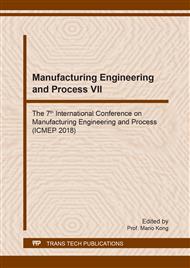p.48
p.54
p.63
p.72
p.78
p.82
p.89
p.96
p.102
Optimal Manufacture Formulas for Waste Tire after Pyrolysis and Lightweight Composites after its Combustion Utilization in Sequence through Statically Analyses
Abstract:
The present research will be included in molding condition of temperature, pressure etc. in addition to heat of combustion test and improve strength of the Lightweight Composites by the adhesives with waste tire after pyrolysis. The results can serve as a reference to the Waste tire pyrolysis ash Lightweight Composites by production process design. Basically, take extrusion molding technique and sintering, the Lightweight Composites are produced for the ash from the Waste tire pyrolysis after combustion utilization. This study uses the Taguchi Methods to find the best formula, from product performance analysis and process technology manufacturing, The Lightweight composite material meets the expectations of the commercial market, As a reference for future research. This study use three variable, include adhesive, molding temperature, molding pressure .In the choice of adhesive, the study selected chemically modified starch adhesive, Melamine - urea - formaldehyde co - condensation resin, Isocyanate adhesives. This study was learned by Taguchi rule, the best formula for the Isocyanate adhesives, molding temperature at 135°C, molding pressure at 3.5kg/cm2. In the above conditions made by the lightweight composite material, with excellent bending strength and water resistance, In the fire performance on the more traditional wood-plastic board. From the commercial market point of view, the lightweight composite materials not only have the characteristics of fire resistance, good bending resistance, waterproof characteristics. In the material cost, because the processing technology to enhance, effectively reduce manufacturing costs, more commercial market competitiveness.
Info:
Periodical:
Pages:
78-81
Citation:
Online since:
July 2018
Authors:
Keywords:
Price:
Сopyright:
© 2018 Trans Tech Publications Ltd. All Rights Reserved
Share:
Citation:


